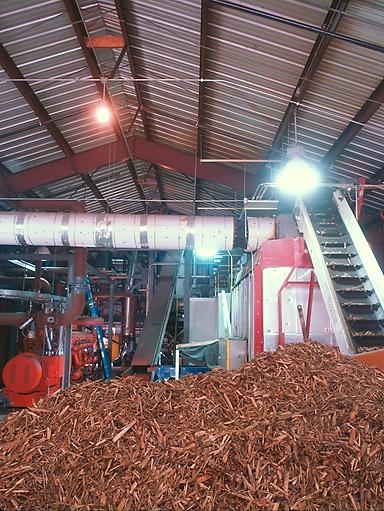Biomass Utilization
Biomass feedstocks are examined for their potential for forming products of incomplete combustion (PICs) under different thermal conditions. Small (200-5000 kWe) energy conversion technologies fueled with biomass are evaluated and demonstrated for technical, economic, and environmental feasibility. Assessments are made of biomass power systems and compared on a cost and efficiency basis with fossil fuel systems for generating electricity. The evaluation of biomass as a source of transportation fuel has been performed by analytical engineering studies of process options and co-feedstock options, especially natural gas, for methanol and hydrogen production.
Fuel Cell/Landfill Waste Gas Utilization
In support of EPA's performance standards for landfill gas control, a
demonstration project involving a commercial fuel cell power plant to
produce electricity from landfill gas was first conducted at a California
site and now is in Groton, CT. A second evaluation was done with a partnership
between EPA, Northeast Utilities, and the Town of Groton with technical
support from International Fuel Cells Corporation, the manufacturer of
the fuel cell. A patented landfill gas cleanup system developed by EPA
is used to purify the gas so that the impurities do not reduce either
the performance or the lifetime of the fuel cell. This technology has
the potential to generate electricity from landfill gas with high levels
of efficiency and with essentially no deleterious air emissions. The goal
from EPA's perspective was to evaluate the ability of the fuel cell to
utilize the cleaned landfill gas to generate electricity. The 200 kW phosphoric
acid fuel cell generated at least 1.6 million kWh, the average use of
electricity for about 100 homes, during the 18-month test period. Testing
was conducted to assess both the fuel cell and cleanup system.
A phosphoric acid fuel cell powered by anaerobic digester gas, which was previously flared, is currently operating at the Yonkers waste water treatment plant in Westchester County, NY. The 200 kW plant has run for over 18,000 hours at levels close to full capacity. It is the first project of its kind in the world. A patented gas cleanup system developed by EPA removes hydrogen sulfide, organic sulfur, halides, and other substances that can poison the fuel cell catalysts. All of the electric power produced is used at the Yonkers waste water treatment facility, resulting in a very favorable economic application of the technology. This ultra clean technology can be constructed virtually anywhere in the U.S.
Biomass to Energy
APB is participating in two research, development, and demonstration projects
that will convert biomass energy to electrical power, resulting in waste
utilization, pollution alleviation, and energy conservation. The goal
of each project is to demonstrate the technical, economic, and environmental
feasibility of an innovative energy conversion technology.
 The Camp Lejeune Energy-from-Wood project demonstrated a biomass-to-energy
conversion technology at a scale of approximately 1 MW of electrical output.
A photo of the project site appears below. The project consisted of a
fixed-bed gasifier, a gas cleaning system, a spark ignited syngas engine,
and a diesel dual fuel engine. The technology used wood residues as fuel
and will produce approximately 1 MWe at the U.S. Marine Corps Base, Camp
Lejeune, NC. The design of the technology, equipment fabrication, installation,
and start-up have been completed. Testing and demonstration have been
completed. More details on this project can be found in a technical paper
published by APB and in the final report.
The Camp Lejeune Energy-from-Wood project demonstrated a biomass-to-energy
conversion technology at a scale of approximately 1 MW of electrical output.
A photo of the project site appears below. The project consisted of a
fixed-bed gasifier, a gas cleaning system, a spark ignited syngas engine,
and a diesel dual fuel engine. The technology used wood residues as fuel
and will produce approximately 1 MWe at the U.S. Marine Corps Base, Camp
Lejeune, NC. The design of the technology, equipment fabrication, installation,
and start-up have been completed. Testing and demonstration have been
completed. More details on this project can be found in a technical paper
published by APB and in the final report.
Biomass Power Plant Demonstration at Camp Lejeune (PDF, 440Kb, 7 pp)
Cratech is progressing with a plan to develop a Biomass Integrated Gasifier-Gas Turbine (BIGGT) power plant capable of producing 1 MWe for commercial use. The BIGGT technology consists of a fuel feed and pressurization system, a pressurized fluid-bed gasifier, and a dry hot gas cleanup assembly coupled to a gas turbine generator set. Phase 1 is complete and consisted of the design, fabrication, and operation of a 0.5 metric ton-per-hour pressurized fluidized-bed gasifier with a slipstream hot gas cleanup system. Phase 2 increased the feedrate to 1 metric ton per hour and uprated the gasifier to operate at 10 atmospheres (981 kPa) with a full-scale, dry, hot gas cleanup system capable of being integrated with a 1 MWe rated gas turbine engine. A technical paper has been published by APB to provide more detail on this project.
A Small Scale Biomass Fueled Gas Turbine Power Plant (PDF, 79Kb, 7 pp)
APB has also engaged in a biomass gasification pilot plant study. More detail on this study can be found in another technical report.
![[logo] US EPA](https://webarchive.library.unt.edu/eot2008/20081016173216im_/http://www.epa.gov/epafiles/images/logo_epaseal.gif)